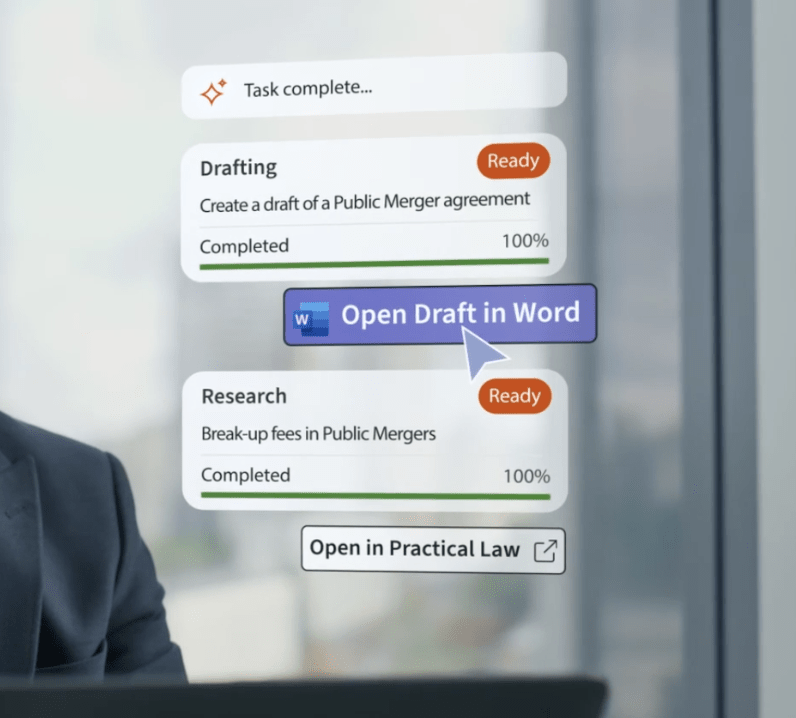Key benefits, considerations, and business value of artificial intelligence (AI) for contract lifecycle management (CLM)
Reviewed by Dan Schaeffer, Sr. Specialist Legal Editor, Thomson Reuters
Highlights
- Artificial intelligence (AI) is redefining traditional, error-prone contract lifecycle management (CLM)
- AI-powered CLM delivers key benefits like faster contract processing and enhanced risk management
- Successful AI implementation in CLM requires a balanced approach, emphasizing human oversight for final approvals and the use of professional and secure legal AI tools
Jump to ↓
What is the contract lifecycle management (CLM) process?
Benefits of using AI for contract management
Key considerations before implementing AI in CLM
Understanding the value of different AI solutions
Contracts are crucial to transactions in every sector, but their management is often complex. Traditionally, contract management meant sorting through correspondence and locating key language in scattered documents. This process is often vulnerable to human errors and inefficient.
The introduction of AI for contract management is creating a paradigm shift. Contract lifecycle management (CLM) powered by AI can automate some tasks to create a better contract workflow. CLM provides legal teams with the ability to reduce time spent on manual drafting, while business teams may benefit from updating, renegotiating, and executing contracts quickly.
This blog will provide a foundational look at how AI enhances each stage of the CLM process.
What is the contract lifecycle management (CLM) process?
CLM is an organized approach to managing a contract from beginning to end. Here’s an overview of the five stages of this process and the potential risks associated with them:
Contract initiation
Generally, initiation of a contract begins when two parties agree to enter into a relationship with each other. The process starts with one party providing the initial draft. Most companies have a template or standard form that they use for particular types of agreement, but simply copying an old template or a previous agreement can lead to mistakes. Companies must spend more time reviewing and adapting the template to the specific situation instead of focusing on higher-level tasks.
Contract negotiation
Communication — Typically, the parties will trade markups and redlined drafts reflecting telephone or in-person discussions. Using email to pass drafts back and forth can result in confusion over the most current deal terms. Prolonged negotiations can cost money and reduce efficiency.
Review — Without a way to signal that a contract is ready for review, it can sit in an inbox for days. With no coordinated system, finance, legal, and corporate departments may have difficulties getting on the same page quickly.
Approval — If there are no workflow approvals, this stage could face delays. Unauthorized or skipped approvals could invalidate the contract.
Contract execution
Without a process in place for obtaining authorized signatures, losing track of signed copies could become an issue for both parties. Missing or invalid signatures could also slow down the transaction.
Contract monitoring
Contract management — Manual contract management can make it difficult to determine if parties are complying with the contract terms. Missed obligations could lead to disputes in fulfilling the contract terms.
Renewal — If the contract includes automatic renewal, effective unless a party gives notice of non-renewal, then a party that misses the notice date could be locked into an undesirable deal for another year or longer or prevented from negotiating better terms.
If the contract requires one or both parties to initiate renewal by a certain date before expiration, then a party that wants the agreement to continue on current terms and misses the renewal notice date, leading to a scramble to renew the contract, possibly on less favorable terms.
Contract closure
Failing to address termination clauses could trigger penalties. Without a system to keep track of terminated contracts, it can be difficult to arrange smooth transitions and to conduct accurate audits and post-mortems.
5 ways AI enhances contract lifecycle management
Using AI tools can help transform static contract documents into actionable intelligence. Not only do businesses benefit from operational gains, but these contracts can become data-rich tools to help with decisions.
“AI tools can help streamline and automate processes at several points in the contract lifecycle. While AI can’t take over all contract management, with proper human oversight and involvement, it can aid greatly in the drafting, negotiation, and monitoring of a contract portfolio.”
Sr. Specialist Legal Editor
Here are five specific ways you can integrate AI into the CLM process:
Faster contract processing
AI can automate contract inquiries and send them to the correct stakeholders. AI can review and summarize email exchanges to extract proposed and counter-proposed deal terms, help generate initial drafts, and summarize received drafts and compare them to a “gold standard” template. This shortens the entire contract negotiation cycle.
Enhanced risk management
AI for contract management can help identify missing terms and detect non-compliant language and categorize them by importance. This process allows parties to take accountability of redline changes and focus their review on critical clauses.
Compliance and governance
AI can compare different versions and check compliance with internal standards and policies and external regulations. This type of analysis can reduce gaps in human oversight and strengthen regulatory compliance.
Actionable contract intelligence
AI can analyze data from a company’s contracts and assist in monitoring performance by extracting key dates and obligations, enhancing real-time oversight. Metadata and trends are key metrics that law firms can use to shape how they conduct business.
Strategic competitive advantage
By using AI, law firms can boost their ability to negotiate better terms, enforce standards consistently, and improve their competitive edge.
Key considerations before implementing AI in CLM
Here are some guidelines to consider before using AI for contract management:
The human touch — Organizations can use AI in the CLM process but should do so only with human oversight. Attorneys are integral in final clause approval, negotiation strategies, and compliance interpretation.
Specialized tools — The key to AI usage is ensuring it is trained on appropriate legal data and that existing systems can communicate with each other using automation tools. It is also critical to be sure that the AI tools you are using are appropriate for the tasks where you intend to employ them.
Accountability — If you use AI, make certain you understand and can explain AI outputs and demonstrate fairness in risk assessments. Choose a system that allows you to identify or determine how AI reaches a specific solution.
Security — Encryption, role-based access controls, and compliance certifications are crucial in meeting industry norms and protecting client information.
Understanding the value of different AI solutions
To measure the value of how AI tools are working for you, ask these questions:
- How do your AI tools increase the efficiency of the CLM process?
- Does AI spot risky clauses or terms that a human might miss?
- Do the operational savings and risk avoidance outweigh licensing, implementation, and training costs?
- Do the tools provide insights on performance beyond automation?
- Is the AI able to manage workflows, extract clauses, and flag risks?
To minimize the hype — and potential misunderstandings — your firm and others you do business with must understand the AI outputs and be able to explain them. Defining what AI can and cannot do is key for establishing parameters for its use.
The future of AI in CLM
AI can help make the CLM process more efficient, improve compliance, and boost profitability. However, simply adopting AI without adequate and effective human oversight is a mistake. Human input and review of output are always critical to the negotiation and compliance process.
Take the first step in exploring how AI can work in your CLM process. Use an AI tool to draft and review your next contract and see how much time you can save.

CoCounsel Legal
Generate custom playbooks from your precedent contracts for tailored negotiation guidance
AI lawyers swear by ↗







